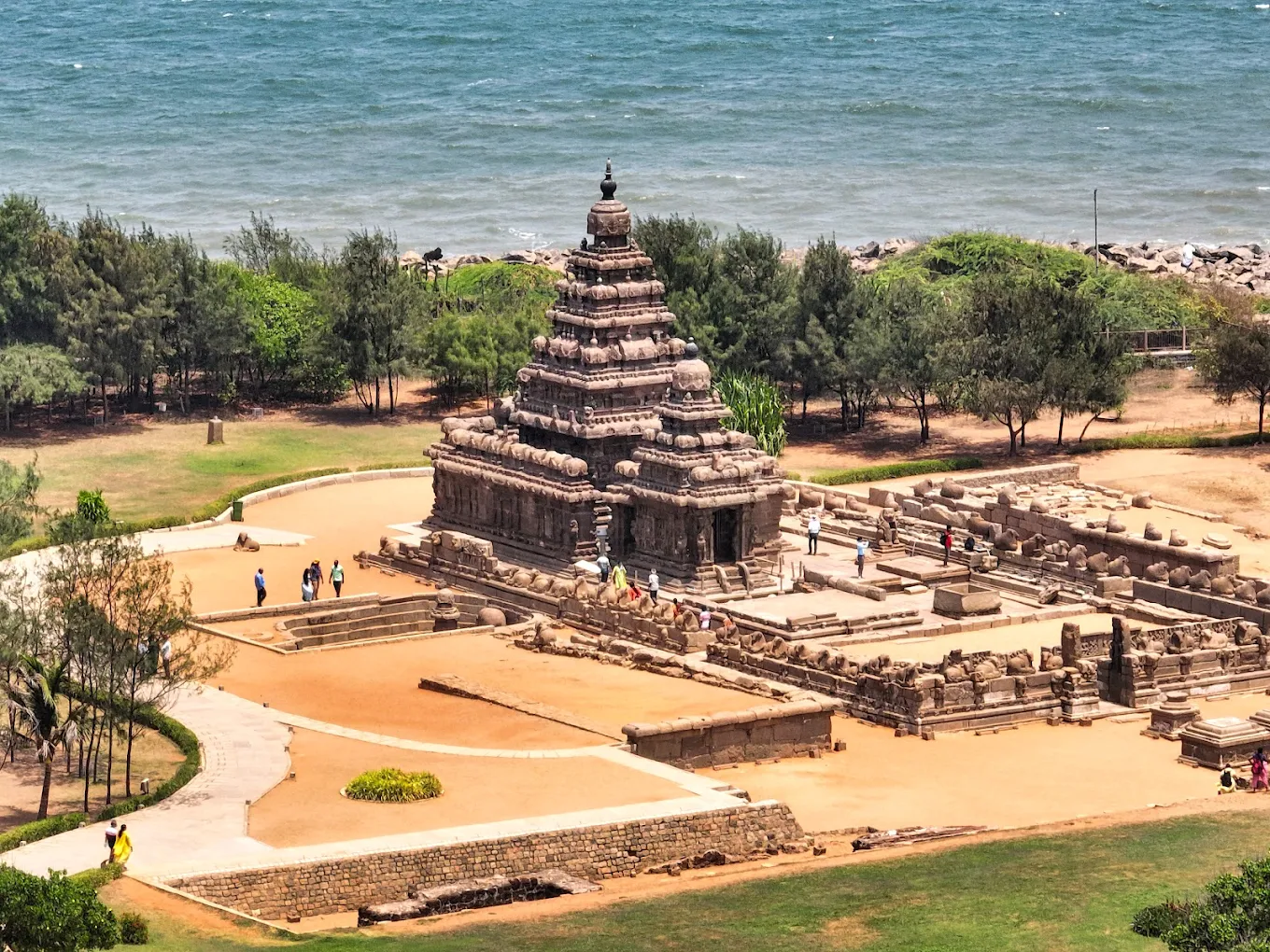Some places you visit because they are famous. Others, because someone recommended them. And then there are places you stumble into, only to realize they hold a quiet magic that stays with you long after you’ve left. For me, the Shore Temple Mahabalipuram was that kind of discovery.
I had read about it in guidebooks—a UNESCO site, Pallava architecture, 8th century, yada yada. But honestly? Nothing prepares you for that first moment when you see the temple standing at the very edge of the sea, its spires almost brushing the sky while waves roar behind it. It feels less like a monument and more like a guardian of time.
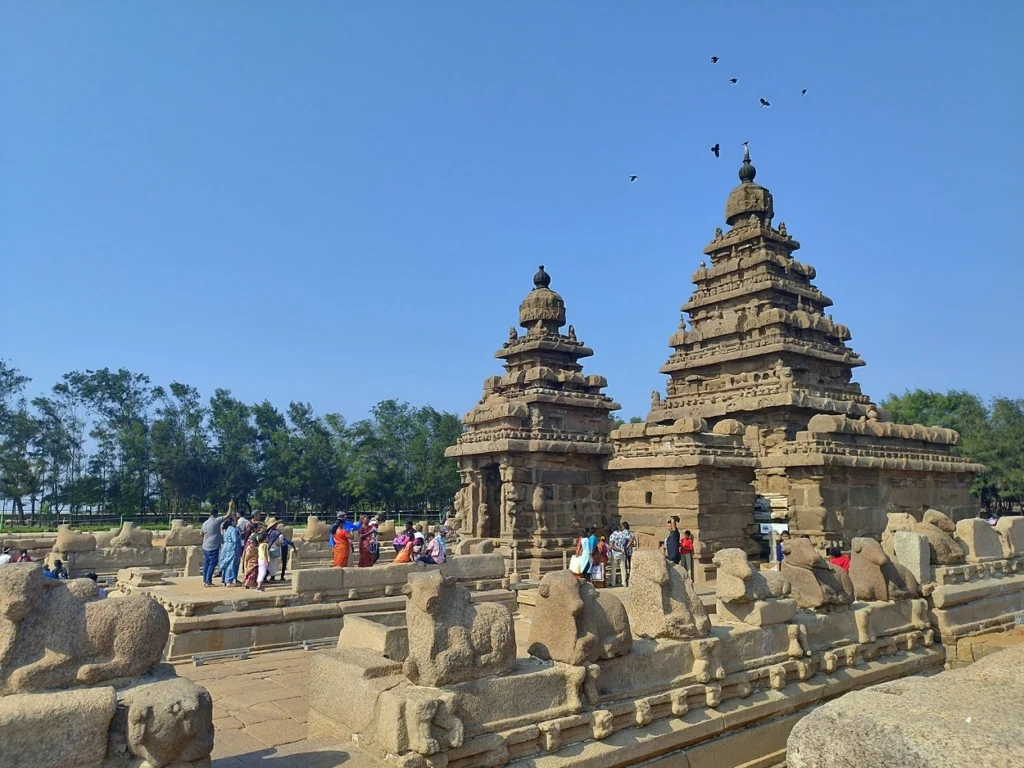
Shore Temple Mahabalipuram
The Shore Temple isn’t tucked inside a city or hidden in hills—it’s right there on the beach. That’s what makes it unforgettable. You walk past souvenir stalls, hear the chatter of visitors, and then suddenly, the sound of the ocean takes over.
Every corner of the temple echoes with that rhythm. You hear the waves while tracing your fingers over ancient granite. You hear them while peeking into the sanctum where a Shiva linga still stands. You hear them even when you’re silent, just staring.
It’s almost like the sea has been chanting alongside the priests for 1,200 years.
Why This Temple Feels Different from Others
If you’ve seen the big South Indian temples like Meenakshi in Madurai or Brihadeeswarar in Thanjavur, you’ll notice something right away—this temple is tiny compared to them. No towering gopurams covered in color, no bustling bazaar streets outside, no massive corridors.
Instead, the Shore Temple is compact, carved with simple yet deeply expressive sculptures. And yet, it doesn’t feel “less.” It feels more intimate.
Maybe it’s because of its location. Or maybe because every sculpture here has been battered by salt winds for centuries, giving them a raw, almost living quality. I remember staring at the row of stone Nandis that guard the temple—some eroded beyond recognition, others still proud—and thinking, “This is beauty that doesn’t need to be perfect.”
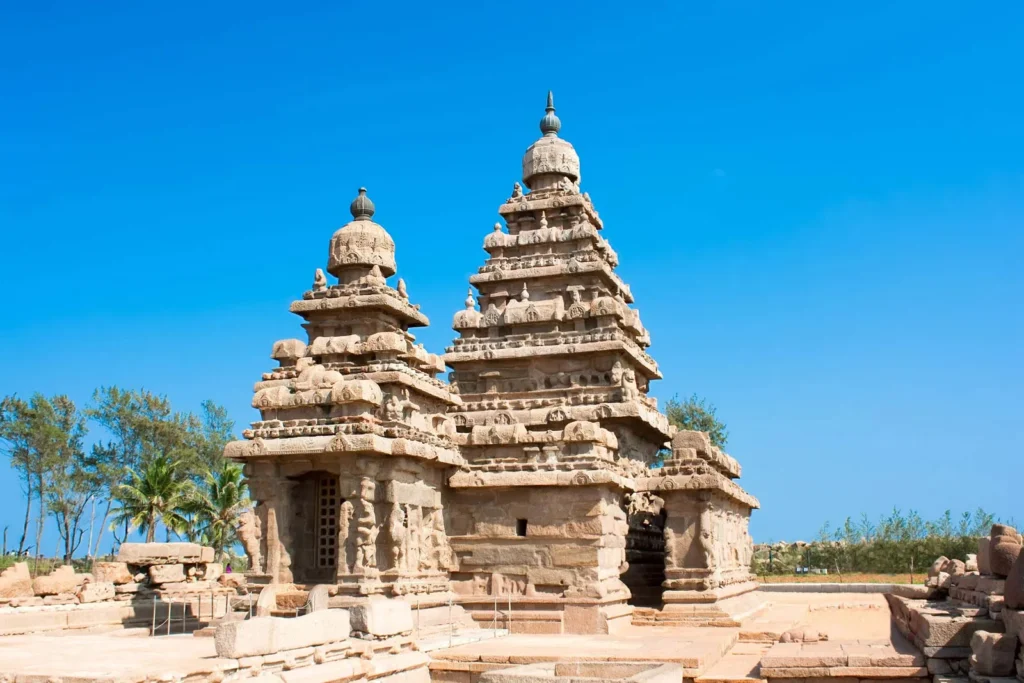
Legends That Refuse to Sink
Ask anyone in Mahabalipuram, and you’ll hear whispers about the Seven Pagodas. The story goes that the Shore Temple is just one survivor of a magnificent set of temples that once lined this coast, the rest swallowed by the sea.
I had gone there to see the Shore Temple, but what I didn’t expect was to walk away with my imagination completely hijacked by the idea of six other temples, lost forever beneath the waves.
Where the Story Begins
The Shore Temple, built by the Pallava kings in the 8th century, is the proud face of Mahabalipuram. But locals will tell you it wasn’t always standing alone. According to legend, there were once seven magnificent temples lined up along the coast, so dazzling that they became known as the Seven Pagodas.
The catch? Only one survives today—the Shore Temple. The other six, as the story goes, were swallowed by the hungry Bay of Bengal.
Now, whether this is pure myth or half-truth wrapped in folklore, the very idea adds an irresistible layer of mystery to your visit.
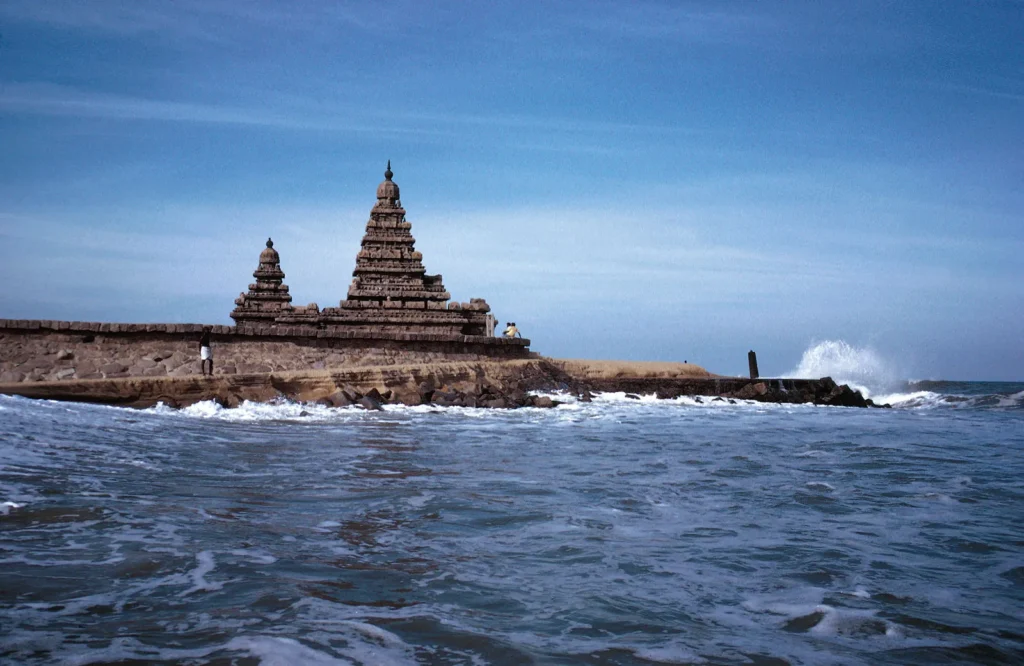
Why the Pagodas Mattered
Back in the Pallava era, Mahabalipuram wasn’t just a temple town—it was a thriving port. Imagine ships from Southeast Asia docking here, sailors spotting the tall temple spires from miles away, guiding them like beacons.
The temples weren’t just places of worship; they were symbols of power, artistry, and navigation. The fact that so many clustered along the shore made the city almost legendary among traders. Some even suggest that European travelers later exaggerated the tale, describing “seven golden pagodas” in their writings.
The Ocean as a Keeper of Secrets
Standing by the Shore Temple, it’s easy to let your imagination run wild. You hear the waves and wonder: What lies beneath?
I found myself staring at the horizon, half-expecting six shadowy silhouettes to rise from the sea at sunset. The idea that entire temples could be buried underwater seems far-fetched—until you remember that coastlines shift, tsunamis strike, and history has a habit of hiding itself.
Interestingly, after the devastating tsunami of 2004, parts of submerged structures were briefly revealed along the shore. Archaeologists rushed in and confirmed the presence of remains that matched ancient descriptions. It wasn’t definitive proof of six other pagodas, but it kept the legend alive.
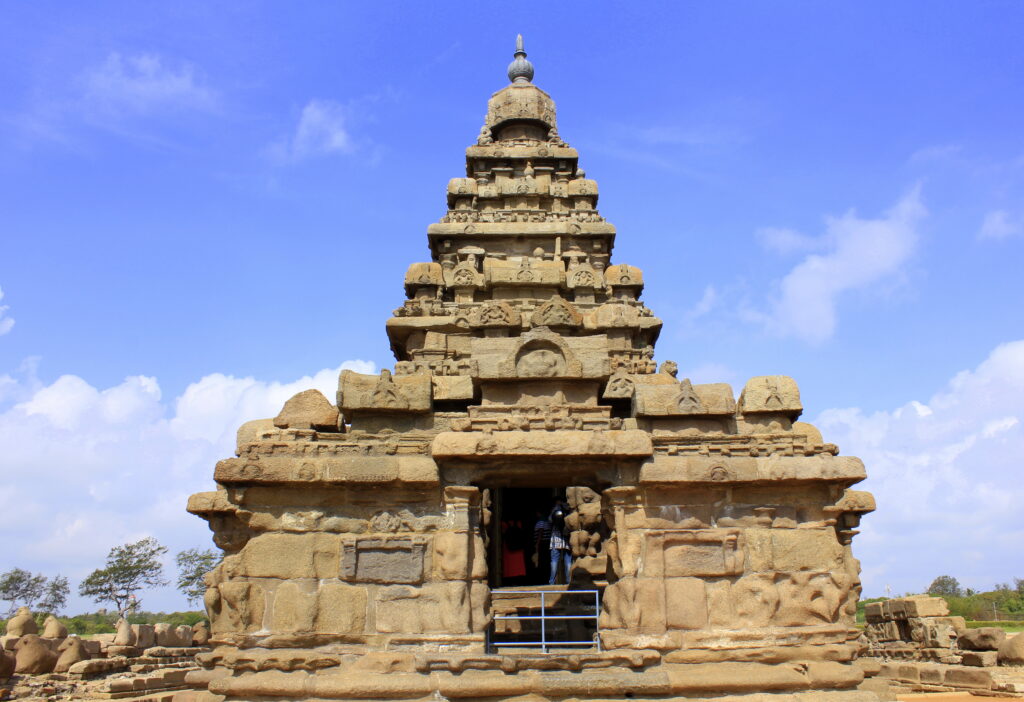
A Walk Through the Town’s Whispers
When you wander through Mahabalipuram, the legend follows you around.
- The Fishermen’s Tales: Ask the local fishing community, and many will tell you about strange stones and carvings caught in their nets. To them, the Seven Pagodas aren’t history—they’re a living truth passed down in stories.
- The Sculptors’ Pride: Modern-day stone carvers in the town like to say they are descendants of the artisans who built those lost temples. Watching them shape granite with the same patience as their ancestors, you can almost believe it.
- The Tour Guides’ Spark: Every guide you meet has their own spin on the legend. Some swear that divers have seen submerged shrines, others that the ocean guards them fiercely so they can never return.
The Tsunami Connection
The 2004 tsunami, though tragic, gave new fuel to the legend. Eyewitnesses reported seeing outlines of structures exposed by the retreating waters. Some said they glimpsed a lion figure, others spoke of walls and steps.
Later explorations by the Archaeological Survey of India did find evidence of rock-cut structures beneath the sea, but the jury is still out on whether these were part of the mythical pagodas or simply other constructions.
Still, isn’t it thrilling to think that the ocean might have briefly unveiled what it has been hiding for centuries?
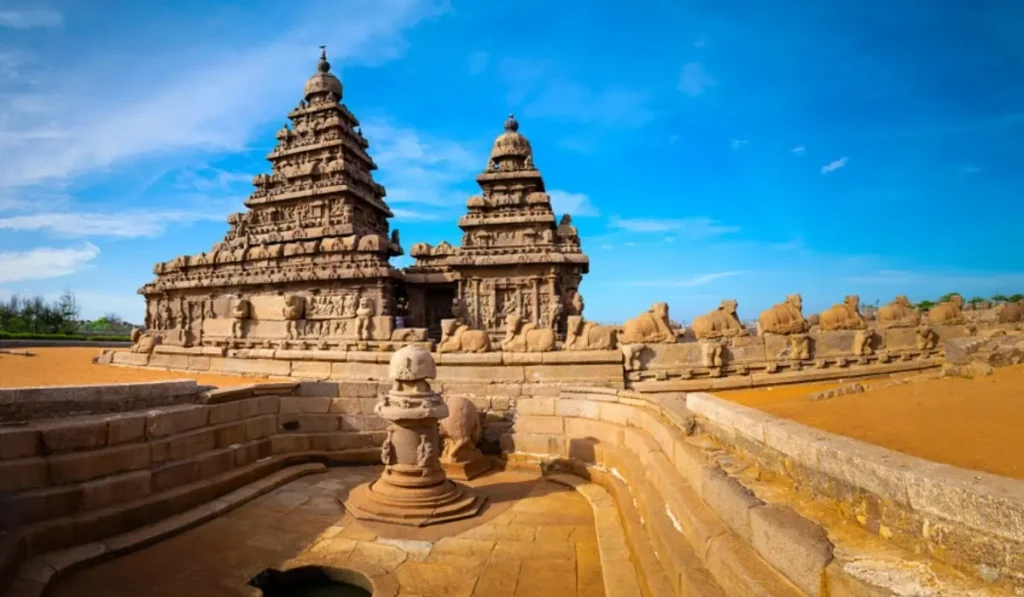
My Favorite Moment: Sunrise
If you ever go, let me give you one simple tip—wake up early. Drag yourself out of bed, ignore the grumbles, and reach the temple before the sun does.
The first rays of light hit the temple spires in a way that feels almost choreographed. The stones glow warm, the sky shifts from purple to gold, and for a few minutes, it feels like time has slowed down just to honor the temple.
I’ve seen sunrises in the Himalayas, deserts, and beaches, but this one—standing with my feet in the sand, the sea wind in my hair, and the Shore Temple in front of me—still feels unmatched.
Life Around the Temple
The temple isn’t in isolation. Mahabalipuram is a living town, and exploring its little corners added so much depth to my trip.
- Fishermen at Dawn: On my way to the temple, I crossed paths with fishermen returning with nets heavy with the morning’s catch. Their wooden boats silhouetted against the rising sun looked like another artwork etched into the coastline.
- Craftsmen with Stone Dust on Their Hands: Mahabalipuram is famous for stone carving even today. Walking down its lanes, I saw artisans chiseling granite into statues—Shiva, Ganesha, even modern designs for export. It felt like the same tradition that built the Shore Temple was still breathing here.
- Street Food Joys: After the temple, I rewarded myself with a plate of crispy dosas and piping hot filter coffee at a roadside eatery. Nothing fancy, but trust me, food tastes better when you’ve just spent the morning soaking up 1,200 years of history.
Stories Hidden in the Stones
One thing I loved was how the carvings seem to tell mini-stories if you look closely. There are lions that look almost playful, gods caught mid-action, and even simple decorative patterns that feel surprisingly modern.
I remember pausing by a sculpture of Lord Vishnu reclining on the serpent Adisesha. The details were faded, but the serenity on Vishnu’s face was still visible. How amazing is it that a hand that carved this more than a millennium ago still communicates emotion across time?
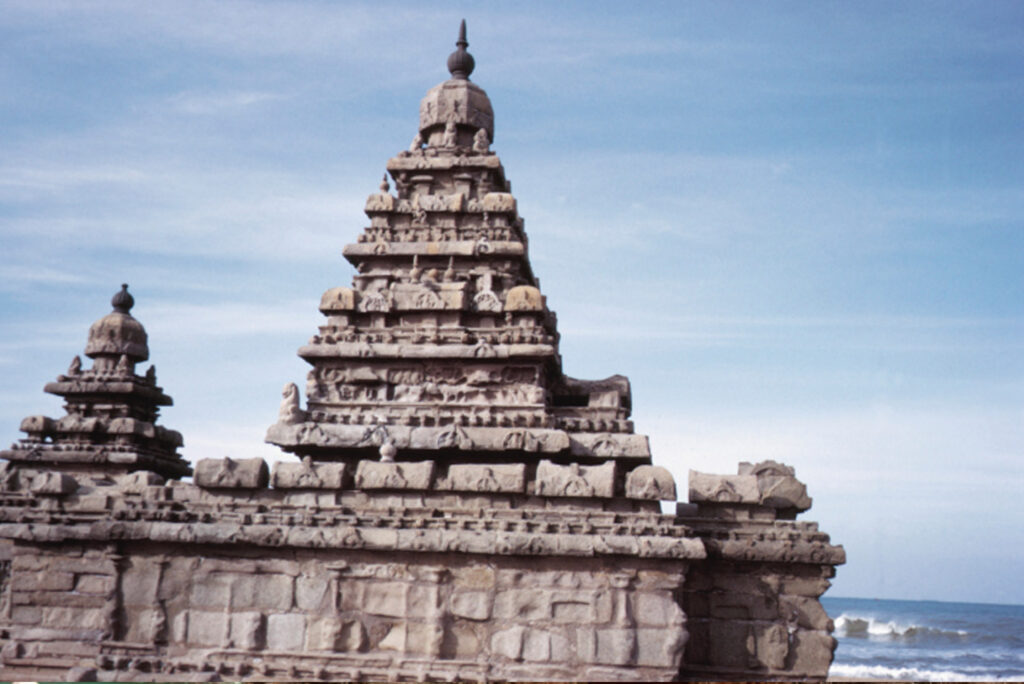
Best Time to Visit Mahabalipuram
So, what’s the best time to visit Mahabalipuram? Let me walk you through each season—summer, monsoon, post-monsoon, and winter—so you can decide what suits your travel style best.
Summer (March to June)
What it feels like:
Mahabalipuram in summer is hot. Temperatures can soar up to 40°C, and the afternoons can feel like the sun is personally chasing you. The heat, mixed with the salty sea breeze, can get a little overwhelming if you’re not used to it.
Why you might still consider it:
- Less crowd: Most tourists avoid summer, which means you’ll have the temples, sculptures, and beach almost to yourself. If you hate long queues and packed photo spots, this season has a hidden charm.
- Budget-friendly: Hotels and homestays often slash prices, making it easier to find good deals.
- Golden sunsets: The sunsets over the Shore Temple are spectacular in summer, with fiery skies adding to the drama.
Tips for surviving summer here:
- Start your sightseeing early in the morning or late afternoon. Afternoons are best spent indoors or under shade.
- Carry a water bottle everywhere—you’ll need it.
- Dress light, but don’t forget sunscreen and a hat. The sea breeze can fool you into thinking you’re not tanning, but trust me, you are.
Verdict:
Summer in Mahabalipuram isn’t the easiest, but if you’re a budget traveler or someone who doesn’t mind the heat, you’ll enjoy the quiet charm of the town.
Monsoon (July to September)
What it feels like:
This is when the Bay of Bengal shows its wild side. Heavy rains, crashing waves, and sudden storms can make Mahabalipuram feel both dramatic and difficult. The humidity spikes, and exploring the rock carvings or temple courtyards during downpours can be tricky.
Why you might avoid it:
- The beaches are risky, with rough tides. Swimming or even walking too close to the water isn’t safe.
- Some outdoor sightseeing can be interrupted by unpredictable showers.
- The humidity can be uncomfortable for long walks.
But here’s the upside:
- The landscape turns lush and green, and the town smells of fresh earth after rains.
- If you’re into photography, the dramatic skies over the temple make for breathtaking shots.
- Fewer tourists mean you’ll experience Mahabalipuram at its most peaceful.
Tips for the monsoon explorer:
- Always carry an umbrella or raincoat—you’ll thank yourself later.
- Wear sturdy footwear; the temple steps and rock surfaces can get slippery.
- Plan flexible itineraries—be ready for sudden weather changes.
Verdict:
Not the best time for a first-time visitor, but if you enjoy solitude, moody skies, and don’t mind the occasional wet shoes, monsoon brings a raw, untamed beauty to Mahabalipuram.
Post-Monsoon (October to November)
What it feels like:
The rains begin to retreat, leaving behind fresh greenery and cleaner air. The weather is still humid, but far more pleasant than peak monsoon or summer. This is like a transition phase—Mahabalipuram is slowly coming back to life, preparing for the winter rush.
Why this period shines:
- Perfect balance: not too hot, not too wet.
- The sea is calmer, so it feels safer and more inviting.
- It’s festival time! Depending on when you go, you might catch Navratri celebrations or local temple fairs.
Traveler perks:
- Hotel prices are still lower than peak winter season.
- You’ll get to enjoy both the greenery left by monsoon and the clear skies of approaching winter.
- The evenings are perfect for strolling along the shore, with the cool breeze carrying stories of the lost pagodas.
Tips for this season:
- Carry light cotton clothes but also keep a light jacket for evenings.
- October can still have the occasional shower, so keep that umbrella handy.
- Book accommodations in advance if you’re planning around festival time, as locals and domestic travelers flock here.
Verdict:
If you want the sweet spot between weather comfort, affordability, and cultural vibrancy, post-monsoon is one of the best times to visit Mahabalipuram.
Winter (December to February)
What it feels like:
This is hands down the most popular season to visit Mahabalipuram. Temperatures range between 16°C to 28°C, making it ideal for long walks, temple hopping, and beachside evenings. The air feels crisp, the sky stays clear, and every corner of the town seems alive.
Why it’s the favorite season:
- Perfect weather for sightseeing without sweating buckets.
- This is when the Mahabalipuram Dance Festival happens (usually in December–January). Watching classical dance performances with the Shore Temple as a backdrop is an experience that stays with you forever.
- Ideal for photography—whether it’s sunrise by the shore, detailed shots of carvings, or colorful local life.
The only downside:
- Crowds. Expect lots of tourists, both Indian and international.
- Hotels and homestays charge premium rates.
Tips for winter travelers:
- Book your stays well in advance—don’t wait until the last minute.
- Evenings can get breezy near the sea, so carry a shawl or light sweater.
- If you want to avoid the peak rush, aim for weekdays instead of weekends.
Verdict:
If you’re visiting Mahabalipuram for the first time, winter is the best season. The weather, the festivals, and the energy of the town make it worth every bit of planning.
So, When Should You Go?
- For perfect weather & festivals: Winter (Dec–Feb).
- For a budget-friendly, quiet trip: Summer (Mar–Jun).
- For greenery & fewer crowds: Post-Monsoon (Oct–Nov).
- For moody skies & solitude: Monsoon (Jul–Sep)—but only if you’re okay with some risks.
When Dance Meets Stone
If you can time your visit in January or February, you’ll witness something extraordinary—the Mahabalipuram Dance Festival. Imagine dancers performing Bharatanatyam with the Shore Temple as their backdrop, their steps echoing the same rhythm you feel in the stone carvings.
I was lucky to catch a rehearsal one evening, and even without the full stage setup, it gave me goosebumps. It’s like the temple itself becomes part of the performance, as if those ancient Pallava kings had always intended it.
Things I Learned (The Hard Way)
- The Stone Gets Hot! I visited once in the late afternoon barefoot, and ouch—the granite floor can burn your soles. Go early morning or carry socks if you’re sensitive.
- Don’t Rush: Many visitors just take a selfie and leave. Give yourself at least an hour. Sit on the grass, watch kids play, and just let the atmosphere sink in.
- Read a Bit Beforehand: Knowing even a little history (like the Pallava dynasty) makes everything more meaningful. Otherwise, it’s easy to dismiss it as “just another old temple.”
A Place That Lingers in Memory
Long after leaving Mahabalipuram, I find myself thinking about the Shore Temple. Not in a checklist kind of way, but in flashes—the salty air, the glow of sunrise on stone, the legends of temples under the sea, the laughter of schoolkids running past the Nandis.
It’s not grand like Angkor Wat or gigantic like the Pyramids. Its charm is quieter, more personal. It feels like a conversation between the past and the present, with the ocean always listening in.
FAQs
Q1. Where is the Shore Temple located?
The Shore Temple is situated on the Coromandel Coast at Mahabalipuram, Tamil Nadu.
Q2. Who built the Shore Temple?
It was built in the 7th–8th century by the Pallava king Rajasimha (Narasimhavarman II).
Q3. Which deities are worshipped in the Shore Temple?
The temple is dedicated to Lord Shiva and Lord Vishnu.
Q4. Why is the Shore Temple famous?
It is renowned for its rock-cut Pallava architecture and as one of the oldest structural stone temples in South India.
Q5. Is the Shore Temple a UNESCO World Heritage Site?
Yes, it is part of the Group of Monuments at Mahabalipuram, listed by UNESCO.
Q6. What are the temple timings?
The temple is open daily from around 6:00 AM to 6:00 PM.
Q7. Is there an entry fee for the Shore Temple?
Yes, Indian visitors pay a small fee, while foreigners have a higher entry fee. Children below 15 years enter free.
Q8. What is the best time to visit the Shore Temple?
October to March is ideal, when the weather is pleasant for exploring.
Q9. What festivals are celebrated here?
The Mamallapuram Dance Festival, held annually near the temple, showcases classical Indian dances.
Q10. How can one reach the Shore Temple?
It is 60 km from Chennai and well connected by road; the nearest airport is Chennai International Airport.

